The EarthSky solar information workforce produced this 1-minute video abstract for you. An almost-X flare!
Solar information for Could 1, 2024: Virtually X flare! Extra to return?
Right now’s prime story: Sunspot area AR3654 has lived as much as its potential and launched an almost-X flare. It occurred late yesterday (23:23 UTC on April 30). The M9.5 flare produced an R2 (reasonable) radio blackout over the Pacific Ocean west of Hawaii. It’s not unusual for a big flare to comply with an earlier massive flare. Will we see a real X flare from AR3654? After yesterday’s blast, the area diminished its magnetic complexity. It’s now exhibiting a beta-delta configuration, indicating a diminished potential for flaring. The solar’s rotation is about to hold this area out of view. It’s positioned near the solar’s southwest limb (edge), and that location is making it troublesome for specialists to research its actual magnetic configuration. Keep tuned.
Final 24 hours: Solar exercise is excessive with the manufacturing of an M9.5 flare. Between 11 UTC yesterday to 11 UTC at the moment, the solar produced seven photo voltaic flares: 4 C flares and three M flares. The most important occasion was an almost-X flare, an M9.5 flare from lively area AR3654 at 23:46 UTC on April 30. Previous to the M9.5, the area produced two small M flares, each of which – like the principle flare – produced R1 (minor) radio blackouts over the Pacific Ocean. The lead flare producer was AR3654 with 5 flares, two Cs and the three Ms of the interval, together with the M9.5 flare. There are 5 areas on the Earth-facing aspect of the solar. There’s a newcomer within the northeast quadrant, AR3663.
Subsequent 24 hours: The prospect for C flares is 99%. The prospect for M flares is 55%. The prospect for an X flare is 10%.
Subsequent anticipated CME: A coronal mass ejection (CME) was noticed in SOHO LASCO C2/C3 imagery. However this eruption was a number of hours after the M9.5. Evaluation is ongoing to find out if there may be an Earth-directed part. A potential CME from the M9.5 flare remains to be underneath evaluation.
Present geomagnetic exercise: Earth’s magnetic area is quiet on the time of this writing (11 UTC on Could). An unsettled stage was noticed late yesterday. Kp = 4 threshold reached at 23:15 UTC on April 30. Lively ranges are anticipated throughout the day at the moment. A G1 (minor) geomagnetic storm could happen in a while at the moment. These situations could prolong via Could 2 as a result of affect of high-speed photo voltaic wind from coronal holes mixed with the potential results of a number of near-miss CMEs from the previous a number of days. Clear skies to you, aurora-watchers!
This picture exhibits solar exercise – with probably the most lively areas labeled – as of 0 UTC on Could 2, 2024. Authentic picture, with out labels, through NASA SDO. Courtesy of NASA/SDO and the AIA, EVE, and HMI science groups, with labeling by EarthSky. Right now’s solar is posted by Armando Caussade. Why are east and west on the solar reversed?
Solar information for April 30, 2024: See the 4 coronal holes! Plus, X-flare potential?
Right now’s prime story: Pleasure is brewing on our star, with sunspot area AR3654 wanting like a possible X flare producer. This large sunspot area has continued to develop over the previous day, and its beta-gamma-delta magnetic complexity signifies that it might produce some severely massive photo voltaic flares. Carry it on, AR3654! We’ve not seen an X flare since March 28, when our outdated buddy AR3615 gave us an X1.1. AR3654 has a number of days to convey the motion earlier than it rotates out of view over the southwestern limb (edge). Earlier than it does, ensure to check out this sunspot by means of protected photo voltaic viewing or eclipse glasses – it’s sufficiently big that you just don’t want any magnification help. What you gained’t be capable to see are the 4 coronal holes which can be presently including to the joy on our solar. These are areas the place the solar’s magnetic area opens into area, letting quick photo voltaic wind pour out. Since this wind can disturb Earth’s magnetic area, these coronal holes are giving us an elevated likelihood for auroras for the time being. So, all we’d like now for an incredible auroral show is an Earth-bound coronal mass ejection (CME) from a giant flare… We’re you, AR3654!
Final 24 hours: Solar exercise has been reasonable over the previous day with the manufacturing of an remoted M flare. Between 11 UTC yesterday to 11 UTC at the moment, the solar launched 13 photo voltaic flares: 12 C flares and one M flare. The most important occasion was an M1.6 flare from AR3654 at 1:14 UTC on April 30. The flare produced an R1 (minor) radio blackout over the Pacific Ocean on the boundaries of the Philippine Sea. The lead flare producer of the interval was AR3654 with 9 flares, together with the M flare. There are presently 5 areas on the Earth-facing aspect of the solar, together with newcomers AR3661 and AR3662.
Subsequent 24 hours: The prospect for C flares is 99%. The prospect for M flares is 35%. The prospect for an X flare is 5%.
Subsequent anticipated CME: Modeling and evaluation of an eruption within the northwest on April 29 at 9:09 UTC confirmed a coronal mass ejection (CME) with a probably Earth-directed part. The influence would happen early on Could 3. No different Earth-directed CMEs had been noticed in accessible imagery throughout the previous day.
Present geomagnetic exercise: Earth’s magnetic area is quiet on the time of this writing (11 UTC on April 30). Quiet-to-unsettled ranges are anticipated for the remainder of at the moment. Quiet-to-active ranges are anticipated on Could 1 as a result of affect of high-speed photo voltaic wind from the coronal holes mixed with the potential results of a number of near-miss CMEs from the previous a number of days. Clear skies to you, aurora-watchers!
Solar information for April 29, 2024: Large sunspot now as extensive as 3 Earths
Sunspot area AR3654 continues to extend in dimension and keep its magnetic complexity. We anticipated extra to return from the area, and it didn’t disappoint. It fired off 15 of the commentary interval’s 17 flares, together with two M flares. The area additionally grew from an space twice that of Earth to greater than 3 times that of Earth. Along with your eclipse glasses, you need to be capable to glimpse it from Earth. AR3654 is positioned close to the equator within the western hemisphere. Because of this if the area erupts, there’s a larger likelihood for photo voltaic stuff to go our approach, particularly photo voltaic energetic particles. Will AR3654 ship extra exercise our approach? Keep tuned.
Final 24 hours: Photo voltaic exercise is reasonable, with two M flares over the previous 24 hours from AR3654. The solar launched 17 photo voltaic flares15 C flares and two M flares. The most important occasion, an M3.7 flare, occurred at 00:54 UTC on April 29. The second occasion, an M2.5 flare, occurred at 00:33 on April 29. Each M flares produced an R1 (minor) radio blackout over the Pacific Ocean. AR3654 grew to an space 3 times that of Earth over the present commentary interval, 11 UTC yesterday to 11 UTC at the moment. The area has maintained its delta area. Two filaments erupted from the northeast and southeast limbs (edges) round 6:52 UTC. There are six areas on the Earth-facing aspect of the solar now.
? ? Solar information for April 29, 2024: Large sunspot continues to develop
? ? Sunspot area AR3654 continues to extend in dimension and keep its magnetic complexity. We anticipated extra from the area, and it didn’t disappoint.
? MORE at EarthSky: https://t.co/xD29wLfm4e pic.twitter.com/WKei6mFYrP
— Dr. C. Alex Younger (@TheSunToday) April 29, 2024
Solar information for April 28, 2024: enormous sunspot area poised for extra motion!
Sunspot area AR3654 doubled in dimension over the previous day. It’s now about 2 planets in diameter. Along with your eclipse glasses, you may be capable to glimpse it from Earth. At its location close to the middle of the solar’s seen disk, it might give us some pleasure over the subsequent few days. That’s as a result of, apart from rising in dimension, AR3654 has elevated in magnetic complexity, indicating a possible for extra flares. It already produced two M flares over the previous day. Will we see extra? Plus, given AR3654’s location on the solar’s seen disk, any eruptions may have an opportunity of sending sun-stuff our approach. And that might imply extra auroras within the days forward. The area seems to have produced a small coronal mass ejection at round 11 UTC on April 27. That occasion might influence Earth in mid-to-late Could 1. Keep tuned.
Final 24 hours: Photo voltaic exercise is reasonable, with two M flares over the previous 24 hours from AR3654. The most important occasion, an impulsive M3.0 flare, occurred at 21:29 UTC on April 27. The second occasion, an M2.1 flare, occurred at 12:33 on April 27. AR3654 is now the biggest sunspot area on the solar’s disk. General, flare manufacturing was decrease over the previous day (11 UTC yesterday to 11 UTC at the moment), with two M and 5 C flares. A brand new Area, 3660, acquired its quantity. There are 9 areas on the Earth-facing aspect of the solar now.
The solar in current days
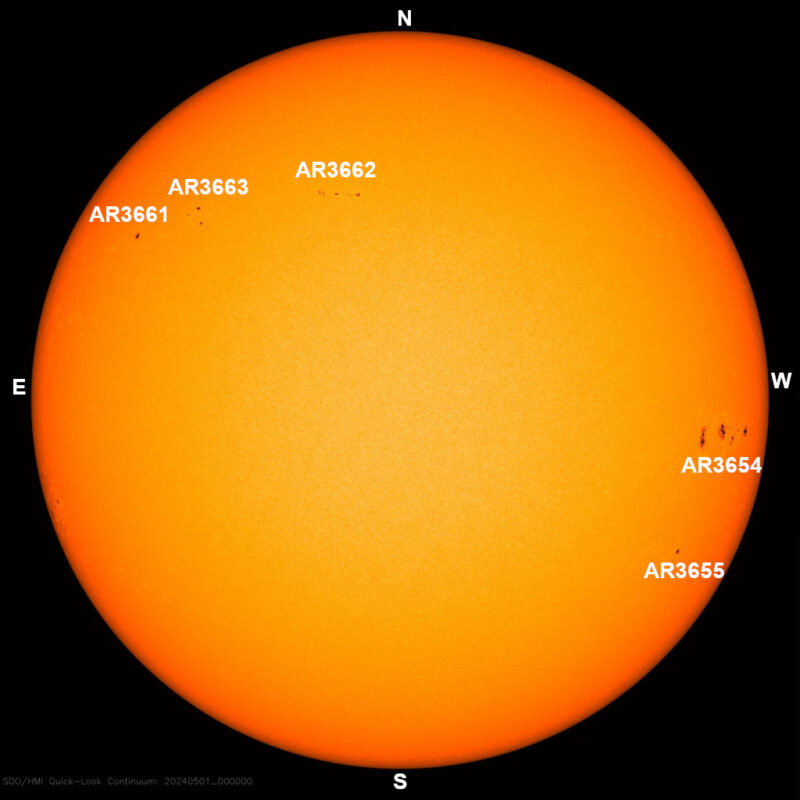 This picture exhibits solar exercise, with probably the most lively areas labeled, as of 0 UTC on Could 1, 2024. Courtesy of NASA/SDO and the AIA, EVE, and HMI science groups, with labeling by EarthSky.
This picture exhibits solar exercise, with probably the most lively areas labeled, as of 0 UTC on Could 1, 2024. Courtesy of NASA/SDO and the AIA, EVE, and HMI science groups, with labeling by EarthSky.
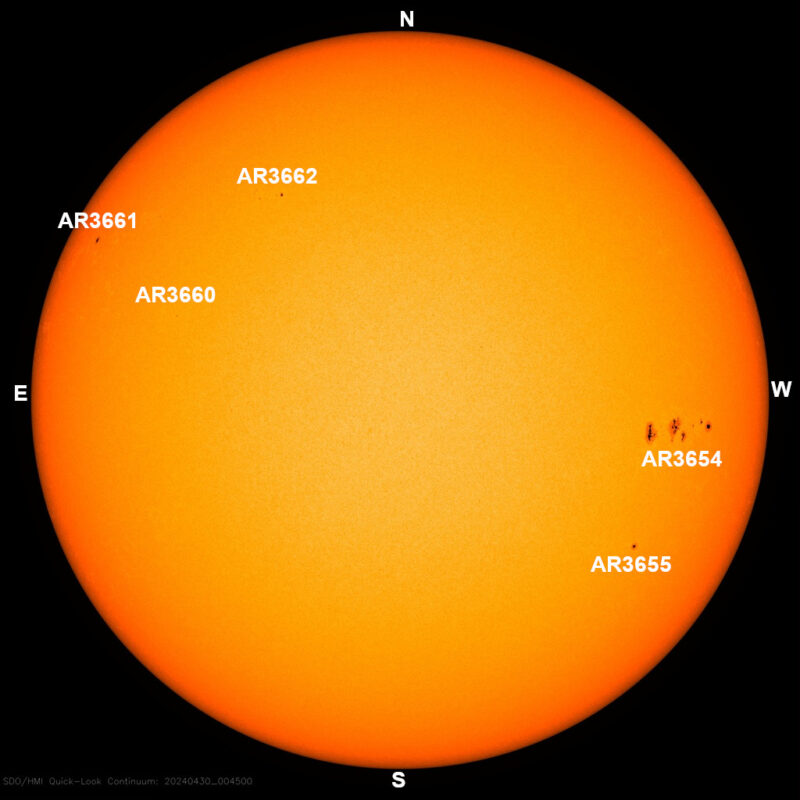 This picture exhibits solar exercise, with probably the most lively areas labeled, as of 0 UTC on April 30, 2024. Courtesy of NASA/SDO and the AIA, EVE, and HMI science groups, with labeling by EarthSky.
This picture exhibits solar exercise, with probably the most lively areas labeled, as of 0 UTC on April 30, 2024. Courtesy of NASA/SDO and the AIA, EVE, and HMI science groups, with labeling by EarthSky.
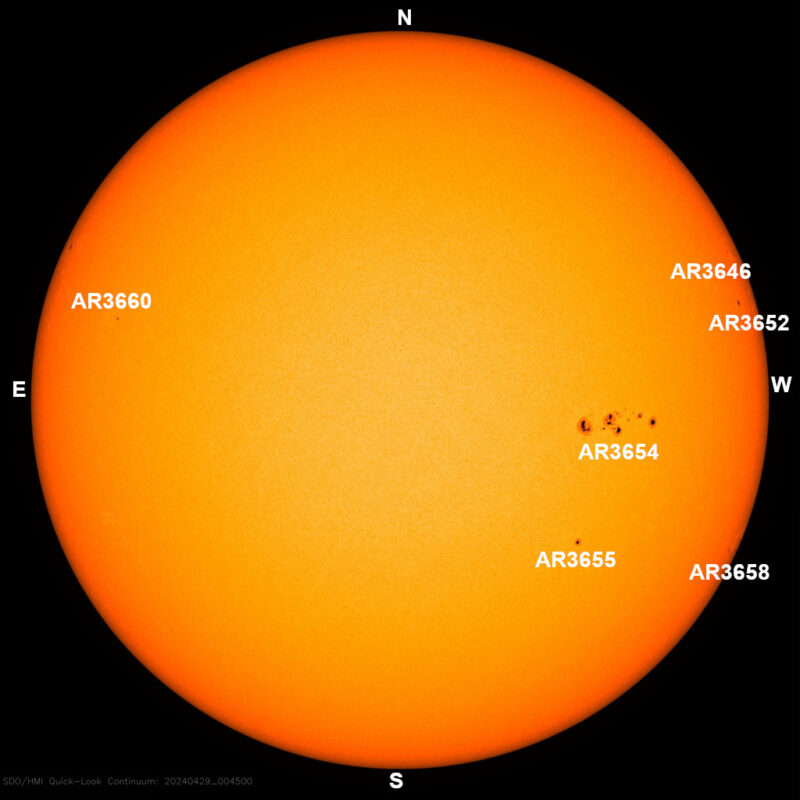 This picture exhibits solar exercise, with probably the most lively areas labeled, as of 0 UTC on April 29, 2024. Courtesy of NASA/SDO and the AIA, EVE, and HMI science groups, with labeling by EarthSky.
This picture exhibits solar exercise, with probably the most lively areas labeled, as of 0 UTC on April 29, 2024. Courtesy of NASA/SDO and the AIA, EVE, and HMI science groups, with labeling by EarthSky.
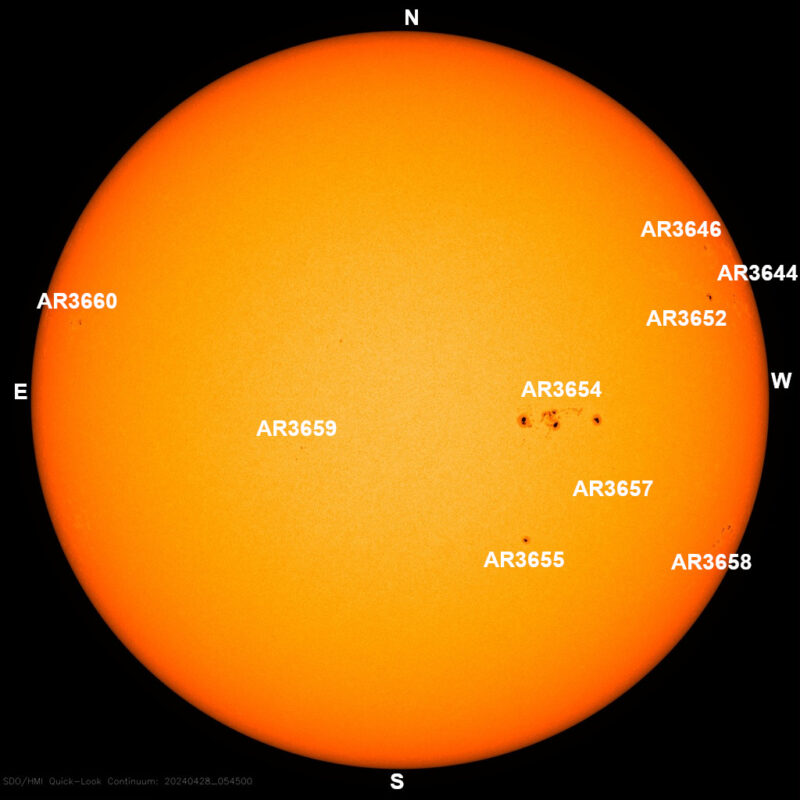 This picture exhibits solar exercise, with probably the most lively areas labeled, as of 5 UTC on April 28, 2024. Courtesy of NASA/SDO and the AIA, EVE, and HMI science groups, with labeling by EarthSky.
This picture exhibits solar exercise, with probably the most lively areas labeled, as of 5 UTC on April 28, 2024. Courtesy of NASA/SDO and the AIA, EVE, and HMI science groups, with labeling by EarthSky.
 This picture exhibits solar exercise, with probably the most lively areas labeled, as of three UTC on April 27, 2024. Courtesy of NASA/SDO and the AIA, EVE, and HMI science groups, with labeling by EarthSky.
This picture exhibits solar exercise, with probably the most lively areas labeled, as of three UTC on April 27, 2024. Courtesy of NASA/SDO and the AIA, EVE, and HMI science groups, with labeling by EarthSky.
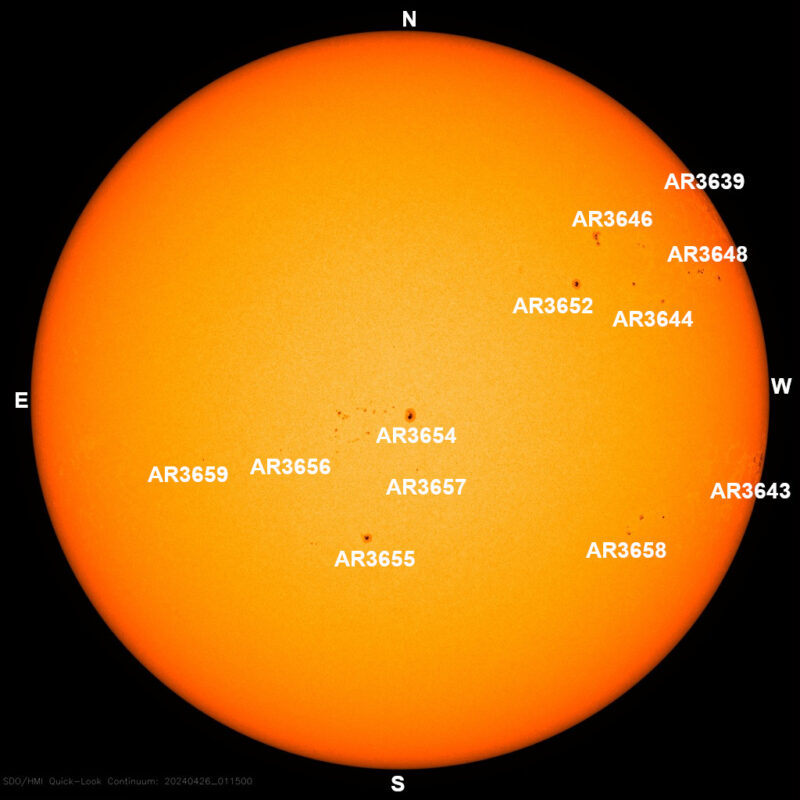 This picture exhibits solar exercise, with probably the most lively areas labeled, as of 1 UTC on April 26, 2024. Courtesy of NASA/SDO and the AIA, EVE, and HMI science groups, with labeling by EarthSky.
This picture exhibits solar exercise, with probably the most lively areas labeled, as of 1 UTC on April 26, 2024. Courtesy of NASA/SDO and the AIA, EVE, and HMI science groups, with labeling by EarthSky.
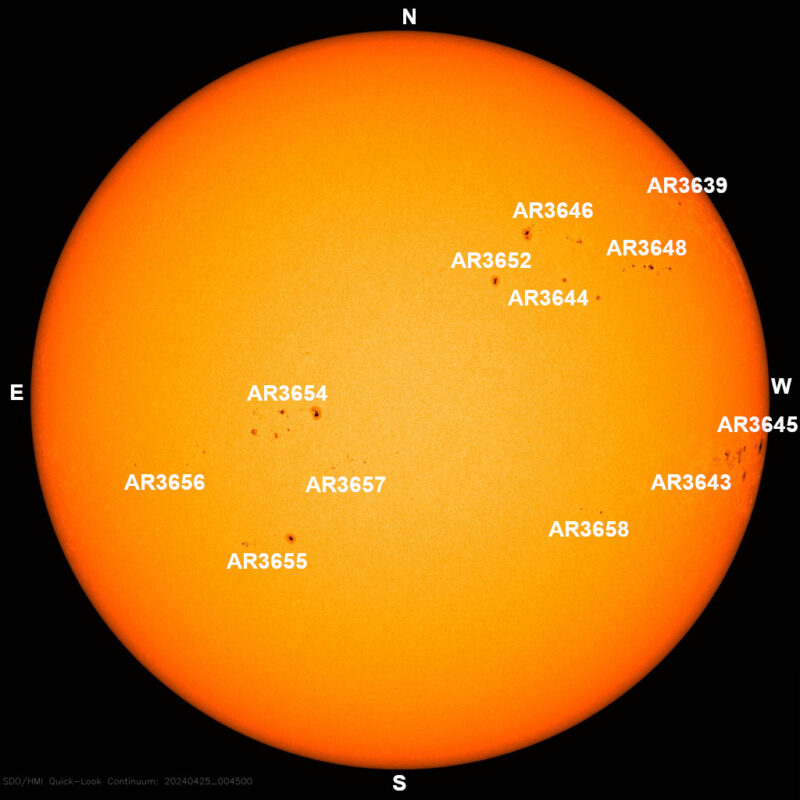 This picture exhibits solar exercise, with probably the most lively areas labeled, as of 0 UTC on April 25, 2024. Courtesy of NASA/SDO and the AIA, EVE, and HMI science groups, with labeling by EarthSky.
This picture exhibits solar exercise, with probably the most lively areas labeled, as of 0 UTC on April 25, 2024. Courtesy of NASA/SDO and the AIA, EVE, and HMI science groups, with labeling by EarthSky.
Solar pictures from our group
Are you a fan of solar pictures? We invite you all to ship us your stunning current images of sunspots and auroras. We love receiving them and sharing them! And to these of you who’ve already posted a photograph to our group web page, thanks.
Submit images right here
View group images right here
 View at EarthSky Group Pictures. | David Hawkes in Sheffield, United Kingdom, captured this filtered picture of the solar on April 30, 2024. David wrote: “Good situations, the enormous lively area 3654 remains to be seen dominating the western limb.” Thanks, David!
View at EarthSky Group Pictures. | David Hawkes in Sheffield, United Kingdom, captured this filtered picture of the solar on April 30, 2024. David wrote: “Good situations, the enormous lively area 3654 remains to be seen dominating the western limb.” Thanks, David!
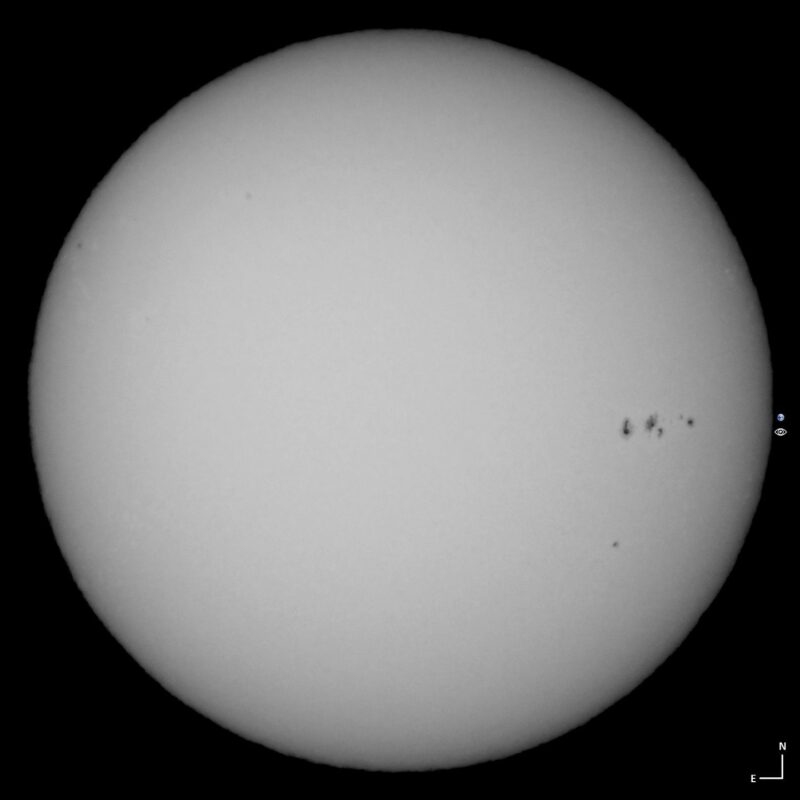 View at EarthSky Group Pictures. Patricio León in Santiago, Chile, captured this filtered picture of the solar on April 29, 2024. Patricio wrote: “AR3654 continues because the dominant sunspot within the photo voltaic face. It’s detectable together with your protected eye alone; seeing was awful as a result of incoming chilly air lots [here in the austral winter].” Thanks, Patricio!
View at EarthSky Group Pictures. Patricio León in Santiago, Chile, captured this filtered picture of the solar on April 29, 2024. Patricio wrote: “AR3654 continues because the dominant sunspot within the photo voltaic face. It’s detectable together with your protected eye alone; seeing was awful as a result of incoming chilly air lots [here in the austral winter].” Thanks, Patricio!
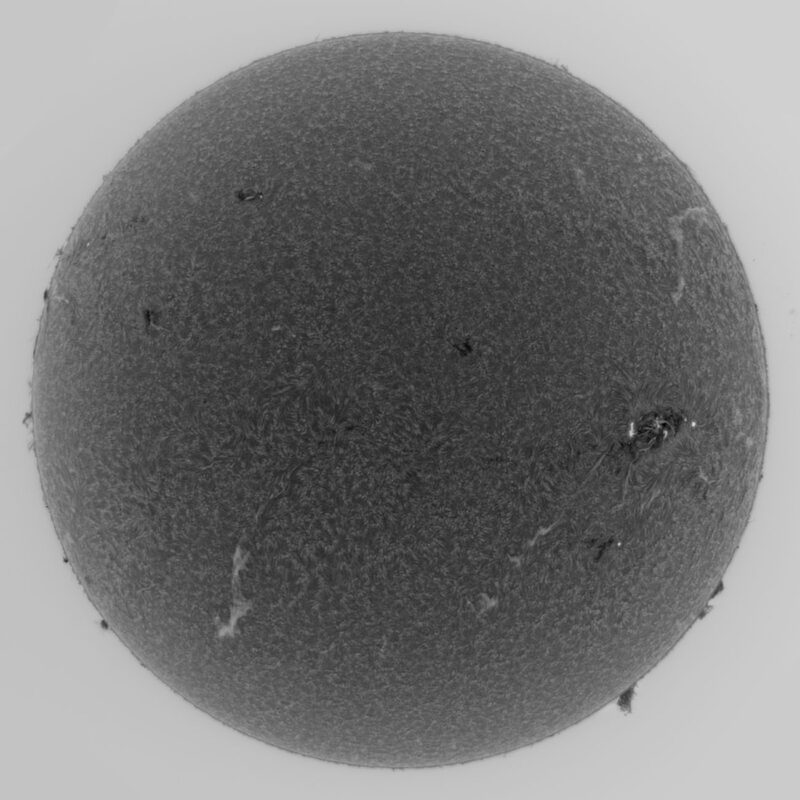 View at EarthSky Group Pictures. | Mario Rana in Hampton, Virginia, captured this filtered picture on April 29, 2024. Mario wrote, “Hydrogen-alpha picture of the solar that includes lively area AR3654 approaching the western limb.” Thanks, Mario!
View at EarthSky Group Pictures. | Mario Rana in Hampton, Virginia, captured this filtered picture on April 29, 2024. Mario wrote, “Hydrogen-alpha picture of the solar that includes lively area AR3654 approaching the western limb.” Thanks, Mario!
 View at EarthSky Group Pictures. | David Hoskin in Halifax, Nova Scotia, Canada, captured this filtered picture of the solar on April 28, 2024. David wrote: “Filtered white gentle picture of the solar captured earlier at the moment. The big sunspot group (inset) is AR3654, which unleashed an M-class photo voltaic flare on April 27.” Thanks, David!
View at EarthSky Group Pictures. | David Hoskin in Halifax, Nova Scotia, Canada, captured this filtered picture of the solar on April 28, 2024. David wrote: “Filtered white gentle picture of the solar captured earlier at the moment. The big sunspot group (inset) is AR3654, which unleashed an M-class photo voltaic flare on April 27.” Thanks, David!
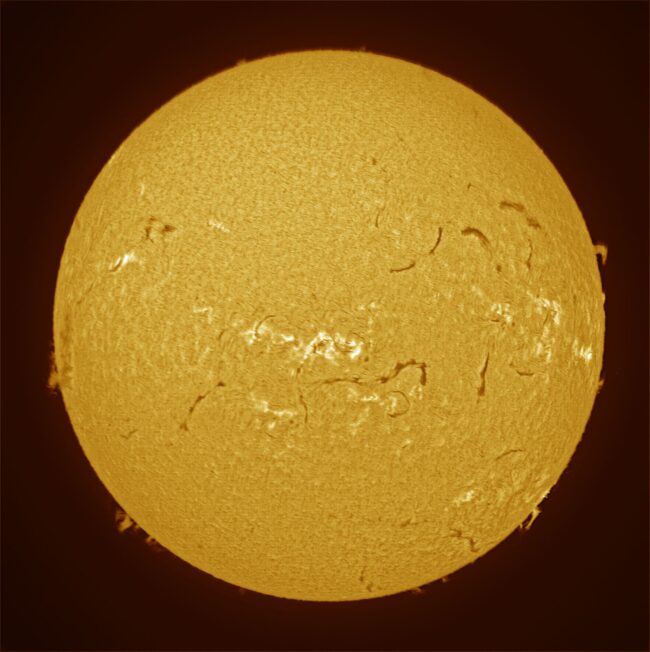 View at EarthSky Group Pictures. | Jim Militello in Tucson, Arizona, captured this hydrogen-alpha-filtered picture of the solar on April 26, 2024. Jim wrote: “The picture exhibits lively areas and quite a few filaments.” Thanks, Jim!
View at EarthSky Group Pictures. | Jim Militello in Tucson, Arizona, captured this hydrogen-alpha-filtered picture of the solar on April 26, 2024. Jim wrote: “The picture exhibits lively areas and quite a few filaments.” Thanks, Jim!
Backside line: Solar information for Could 1, 2024. Virtually X flare! AR3654 produced an M9.5 flare — simply shy of an X flare — dwelling as much as its potential.
C. Alex Younger
View Articles
Concerning the Writer:
C. Alex Younger is a photo voltaic astrophysicist learning the Solar and area climate. Alex is captivated with sharing science with numerous audiences. This led him to start out The Solar Right now together with his designer spouse, Linda. First by means of Fb and Twitter then including an intensive web site thesuntoday.org, the 2 work collectively to have interaction the general public concerning the Solar and its function in our photo voltaic system. Alex led nationwide engagement efforts for the 2017 complete photo voltaic eclipse. He’s the Affiliate Director for Science within the Heliophysics Science Division at NASA Goddard Area Flight Middle.
Raúl Cortés
View Articles
Concerning the Writer:
Raúl Cortés studied engineering on the Autonomous College of Nuevo León in Monterrey, Mexico, obtained a scholarship to proceed his research in Japan and after returning to Monterrey he acquired credit on MBA from the Graduate College of Mechanical and Electrical Engineering School. He grew to become a instructor on the College UANL educating Math and Physics and devoted the remainder of his skilled profession to serve in engineering areas for USA, Japan and Germany based mostly companies. His ardour for the skies return to when he was a baby, all the time intrigued concerning the stars and constellations and studying and researching concerning the matter. From 2010 on, he devoted his consideration to photographing the celebrities, constellations, the moon and the solar. Raúl’s work on his images has been revealed and posted on the ESC in addition to in different platforms and has gained consideration to be revealed by native Monterrey newspapers.
Armando Caussade
View Articles
Concerning the Writer:
Armando is nicely referred to as an astronomy educator, after 30+ years main intensive initiatives of public outreach and 10+ years educating in schools. As considered one of solely a handful of Puerto Rican science communicators throughout Comet Halley’s final go to, he assumed a pioneering function beginning in 1985 when science was simply starting to enter the native mindset; over time his work introduced significant change to the tradition, inspiring folks to pursue pursuits in science and know-how. His affiliations embody Ana G. Méndez College–Cupey, the place in 2014 he spearheaded an 8-course extension program specializing in observational astronomy, the primary ever within the island.









